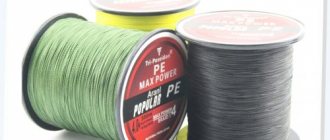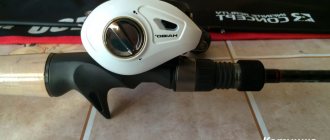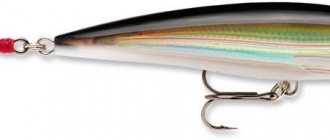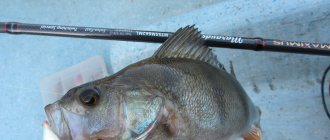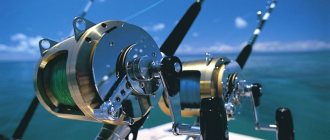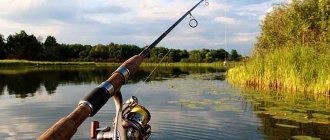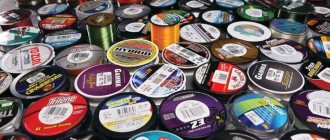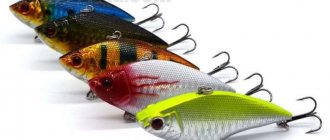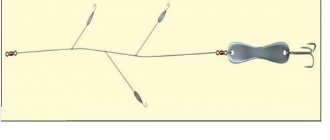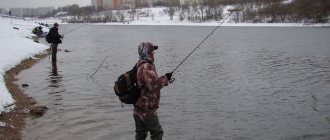The correct spinning rod for twitching is a condition for successful fishing with wobblers. During steady and pause only cranks work. For minnows, sheds, and poppers, twitching is the main animation technique. Therefore, anglers who decide to try wobblers without delving into the issue often fail to fish with them. Spinning for wobblers is a tool that a fisherman uses to animate these baits, and not just any rod from a store that just looks good will do.
The wobbler itself does not catch, just like with an incorrectly selected fishing rod. Let's take a closer look at how to choose a spinning rod for twitching. Wobblers in general require some knowledge. However, at the same time, they are not the lot of athletes and are easy to master for amateur fishermen. You just need to approach the study of the issue thoroughly, and not throw the first bait you come across into the water and pull.
Twitching tackle
The choice of spinning rod for wobblers should be made when the picture has already been more or less drawn in your head - who to catch, where, and with what kind of bait. In addition to the usual test requirements, a spinning rod for twitch is selected according to other, sometimes implicit for a beginner, characteristics related to the fishing characteristics. Asking in Yandex the request “the best spinning rod for twitching”, choosing the first one from the rating on an incomprehensible site and buying is the wrong approach. In this case, the fisherman on the pond will be disappointed.
The fishing rod for wobblers is chosen carefully. This is a thin tool for narrow conditions. Therefore, first we study the theory, articles on the Internet and videos on YouTube. Spinners, as well as at least jigs, can be caught with any rod that matches the test. But not with wobblers - for each group of these baits, with the imposition of fishing conditions, its own stick is required. Therefore, you need to choose a form only after you understand the conditions in which it will be used, and specific wobblers - large minnows or medium ones, shads, with a jig and spinners together or purely for twitch.
Twitching is a complex of animations based on jerks, pokes, pulls and pauses. Not every spin can pull any wobbler due to the stubbornness of these baits in water. Before choosing a fishing rod, you need to clearly understand what exactly it is intended for. All information can be found on our website, as well as through the links in this article.
What is twitch fishing:
Requirements for the rod
As with other lures, you need to start looking for a rod for twitching with a test:
- For large minnows 130 mm and deep large cranks with a large shovel - with a top dough of more than 25 grams, MH and H markings. Medium to heavy.
- Medium wobblers and shads - medium in the range of 14-25 grams.
- Light – small minnows, shads, 7-15 gr.
- Ultralight – for small cranks and minnows, up to 7 g.
Build
Wobblers provide resistance during the jerk. After the jerk, you need to give the line slack so that the bait makes the correct wobbling and rolling. More details about this can be found in the article on twitching techniques at the link above. Only a spinning rod of fast or extra fast action is capable of making that very correct jerk on twitching.
The rod should not fall during the jerk, so the usual medium-action spinning rods for spinners, noodles, and wobblers will not work. For wobblers – Fast and Extra-Fast. Only cranks can be pulled evenly with a soft rod. Well, the sheds will at least somehow be able to be animated with noodles, but they won’t show their maximum capabilities.
Length
The longer the rod with the same tests and action, the heavier it is and the less sensitive to the behavior of the wobbler in the water. In twitching, the shorter the stick, the better. Pure twitchers often use spinning rods 1.83-1.9 meters long. Universal size if you need to fish from the shore with spoons and jigs - 2.1, 2.4 meters. Twitching involves jerking with the hand. Only a short stick, a light stick with a selected coil will allow you to do this comfortably all day.
For the same reason, two-handed wobblers are not suitable. The handle needs to be short so that when you jerk the hand, it passes in front of the forearm without catching it. The best wobblers are a short, spaced handle, on which the cork or EVA shell is divided into two sections, on the butt and foregrip (the section above the reel). It is desirable to have a hookkeeper and a ring for hooks to conveniently hook the wobbler when moving with a spinning rod.
Spinning rod for twitching large wobblers:
Despite the fact that the concept of a large wobbler is relative, nevertheless, most often anglers ask it when they want to purchase a spinning rod for twitching 110-130 mm minnow wobblers such as DepsBalisong and OSPAsuraRudra. As we already wrote above, a powerful hard rod with a test weight of up to 28-35 grams will be enough, because... These wobblers have their own game and many agree that they do not need an aggressive twitch. However, the weight of the bait 24 grams is not the limit. There are a lot of wobblers weighing 30, 40 and more grams. For such heavy baits, you need a class of spinning rod with a large margin of safety so that it does not fail during jerks. They are also called jerk rods. Such spinning rods have an upper test of up to 80, 100 and 150 grams, and sometimes more. They allow you to set the desired game for a large wobbler (jerk). It is important to know that, as a rule, such rods are made in a casting design, since such a persistent bait as a wobbler, and even having a weight of 50-70 grams, will very quickly render an inertialess reel unusable, and one that could cope with such weights is not the only one season, will weigh about half a kilo or more. Therefore, it is quite possible that you need a casting spinning rod for twitching large wobblers. The casting kit has a number of advantages:
- Possibility of using a thick cord that does not affect the flight range of the wobbler. This is very important because... any overlap will not lead to the shooting of heavy bait, and also allows you to pull the wobbler out of the grass and reeds;
- More accurate and controlled casting;
- No arc during windy conditions. There is such a concept among fishermen as to twitch the arc. This occurs when, during a crosswind, an arc is blown out of the cord and the main jerk of the spinning rod falls not on the bait, but on the cord. There is practically no such thing in cartoon gear.
Selecting a spinning rod for twitching according to the test
Testing a spinning rod under twitch with high values makes it possible to use slightly smaller baits. You can also use a stick for large pike minnows and shads, such as khamsin, weighing 8-10 grams - the casting will not be as far. But you can’t pull a 130 minnow with light. Light and medium spinning are chosen only if large minnows are not used - only small and medium ones. And so on for the rest of the calibers, downwards. It depends on the main set of wobblers that the spinner assembles.
Spinning rod for twitching large wobblers
The spinning test for large wobblers should ideally be at the upper limit of 30-40 grams, usually about 35. Non-resistive large minnows can be pulled normally with 20 gram sticks. However, they will not pull through Rudra, 130 Rerange, Rope. Therefore, you need a quick stake, and not a log, but a neat, lightweight rod that you can use to make jerks with your brush throughout the entire fishing trip.
With a spinning rod for twitch 130 wobblers, you can animate medium minnows and shads weighing 8-15 grams, but you need to pull carefully so as not to overdo it. If you jerk too hard, these baits won’t produce a normal game. Here the spinner makes the choice. If the basis is 130 for pike and a few medium wobblers, we choose a twitch spinning rod for large wobblers. If a set of medium minnows and a couple of non-resistant big-minnows - the medium is around 15-20 grams. Medium spin is easier to handle with light minnows and sheds, such as chaos or khamsin, which require careful jerks without jerking.
More information about large wobblers for pike
Light medium twitching
A medium rod with a test weight of up to 20 g is suitable for pulling 90-110 lures, as well as small minnows. If you don’t use medium minnows, we are looking for a light spinning rod. Light will not pull through stubborn medium-sized wobbles, but will cope perfectly with both 10-gram shad that do not require sharp jerks, and with small crankbaits weighing 3-4 grams.
For aggressive twitching, mainly for pike and large perch - medium caliber spinning rod for wobblers 65, 70, 80 mm - up to 110, if it pulls. Spinning rod for light twitching - for small and medium-sized perch, chub, and occasional pencils in urban reservoirs where there are few large pike. It is still advisable to target large pike and pike perch with large minnows and a serious caliber of tackle.
Article about medium wobblers - shads and cranks for pike
Ultralight
Spinning for ultralight wobblers also needs a fast spinning rod. In this caliber, twitching is light twitching, but the action still needs to be fast. Soft solid inserts, as for microjig, will not work. You need to look for a tubular or hard solid so that the blank works normally when the microwobblers twitch.
Spinning rod structure for twitching:
Almost all anglers are of the same opinion that a twitching spinning rod should have an ultra-fast or fast action. The main reason is that for the correct play of a rather large minnow wobbler, a short and hard jerk is needed, which will correctly animate such a wobbler. And it is the fast and ultra-fast action that ensures such “correct” wiring. For those who are going to buy a spinning rod for twitching, it is important to understand that the rule “the more expensive the better” is not so critical for this type of fishing. Of course, more expensive models have a louder design, fittings and are noticeably lighter than budget ones. But it is in this type of fishing that the hands and head of the fisherman have the most decisive importance, and in particular, the result of twitching fishing depends on his actions.
Selection according to the nature of fishing
In twitching, choosing a rod based on the test alone is not enough - there are also factors that intersect with each other. The best spinning rods for twitch are tailored not only to specific weights of wobblers, but also to fishing conditions and anglers’ habits. Let us highlight several aspects that also need to be taken into account when searching for a fishing rod. You need to check these points yourself in the store using test rods, or by watching a video on YouTube if the spinning rod is ordered via the Internet.
- If we fish from the shore, it is better to take a length of 2.1-2.4 meters in order to operate normally among the bushes and make a longer cast. From a boat, shorter ones, 1.8-2.1 meters long, are more convenient.
- If you need a purely twitch spinning rod, choose a hard stake with a fast or extra fast action, with a medium taper from butt to tip, short. This is a purely twitching tackle, which is problematic for fishing with spoons or jigs. But only such a form will give maximum sensations from playing with a wobbler.
- The lack of taper allows the entire blank to work. Such sticks are less resistant to failure during a strong jerk of large wobbles, but they are more comfortable to fish with if spinners and jigs are used together with wobblers
- Carrot blanks, thick and powerful at the butt, with a strong taper towards the tip, are designed for harsh conditions; they are good at tearing pike out of grass and reeds. Preferred for catching large pike in conditions of snags, algae, reeds, when you need to force the landing.
Universal rod for wobblers and jigs
In this article we consider spinning rods almost purely for wobblers. However, most amateurs do not switch to wobblers completely, but simply add these baits to their arsenal. Selecting a rod for jigging and twitching are two different tasks. However, there are universal fishing rods, even in the budget segment. When choosing, the angler needs to clearly understand whether a stick is selected with a bias towards a jig or into wobblers.
Many budget twitch spinning rods are initially created with the possibility of universal use. Naturally, before choosing, you need to fully study a specific model using forums, videos, and compare it with your own fishing conditions and baits.
More details - universal spinning rod for jig and wobblers
Spinning reel for twitching
There is no need for any special reel for twitching - the main thing is that it fits normally into the tackle in general in terms of reliability, balance and size. The reel for twitching large wobblers is a regular, reliable mincer, size 3000-4000, for a 15lb cord. For light and medium - 2000, 3000. Gear ratio, reliable main pair, traction force - depending on the caliber of the spinning rod.
A light reel is preferable for twitching tackle, since the angler uses a spinning rod with a brush. With the correct technique, even when jerking large wobblers, the reel will not be killed - the main thing is to pull with the rod, and not with the mechanism. Read more about the right spinning reels
Choosing a reel for twitching
Despite the noticeable popularity of twitching with casting gear, the main and main thing remains a regular spinning set with a spinning reel and a corresponding rod. It is precisely such gear that we will primarily discuss.
Oddly enough, there is not a single model of a spinning reel on which it would be directly written: “twitching reel.” That is, it seems that they are all universal. However, not all spinning reels are equally suitable for jigging and twitching.
Each case has its own specifics, and depending on this, one or another model is selected. So, in twitching, the main requirements for spinning reels are as follows:
1) Good laying of the cord or fishing line.
The fact is that no matter how hard we try to evenly wind the fishing line or cord onto the spool, during jerking retrieves we still won’t be able to do this completely. Yes, and there’s really no reason to strive for this.
A reel that more or less normally copes with the variable tension of the cord or fishing line, as well as the usual accuracy and attentiveness of the fisherman while fishing, will be sufficient. By the way, the reel does not necessarily have to be very expensive - a price tag of $50 or more can already be considered acceptable.
2) Ability to withstand shock loads.
Again, no matter how carefully and gently we twitch, the coil will still be subject to significant shock loads. This is the specificity of all jerk wiring.
Even expensive and very high-quality reels can turn into rumbling and falling apart products after just a few regular fishing trips. To prevent this from happening, you must choose a reel with a powerful main pair; you should not take any lightweight modifications with the inscriptions “Ci” or the like.
3) Endurance and traction.
In fact, a continuation of the previous paragraph, but here also lies the ability of the coil to withstand significant loads for a long time, and also, if necessary, have a reserve of power. This is explained by the fact that even minnow wobblers are capable of creating a noticeable load during wiring, especially larger ones.
In addition, you often have to pull out not only fish, but also a bunch of algae. And if all this is done as smoothly as possible and in a gear-friendly mode, then there won’t be much time left for the fishing itself. From here it is easy to predict the result of fishing.
4) Small weight and dimensions.
Previously, when reading such requirements for coils, I treated them with considerable skepticism. Like, just think, an extra 50 or 70 grams of weight is nonsense. Years have passed, and now I understand and also appreciate the desire of manufacturers to minimize the weight and dimensions of their products.
This should not, of course, be to the detriment of the previous points of the requirements, but small weight and dimensions are by no means the last thing. An excessively massive reel will certainly introduce an imbalance into the overall equipment of the tackle; movements (twitches) will certainly be less clear. Perhaps a beginner will not immediately notice this, but the fish will certainly “feel” it.
Casting rods
Rods with a multiplier trigger were originally created for jerking retrieves. Followers of casting fishing claim that the best spinning rods for twitching are trigger ones. However, ordinary spinning rods with inertia-free rods cope with wobblers no worse - our conditions, after all, are not tuna fishing in the sea. Here every sandpiper praises his swamp. In our country, most twitchers use regular spinning rods with spinning rods, but in the West, baitcasting is more popular. More about casting spinning rods
Casting spinning rods are short, powerful, with reel seats for special multiplier reels. The rings on such forms are on a short stem, and on the handle there is a trigger for a specific grip.
Twitching cord
On spinning rods for light twitching, the usual cords for this caliber are used, 0.12 mm and thinner. The diameter of the cord for twitching large wobblers is needed more - 0.14, 0.16 mm, with a breaking load of 15 pounds. This is due to the increased load when performing jerk wiring. For twitching, you need a reliable braid that can withstand multiple increases in the load when jerking, especially at a knot.
For wobblers for pike, a twisted leash is usually used, with or without a swivel. If we tie it to a swivel, we use a palomar knot, it is the most tensile. The braid can also be tied using a knotless installation - directly into the twist of the string or through a knotless clasp. More details - how to tie a wobbler correctly
Errors in choosing the thickness of fishing line or cord
- The first and probably the main one. Thicker is better. Yeah, that means you can “throw” it with “bad” force and pull out the pike fisher “all the way through” without fear of a cliff, and at the same time uproot the snags from the fished area.
This error is especially aggravated with the first breaks of the wobbler itself or the wobbler with fish. As a rule, this system for beginners is most often used with monofilament fishing line, for which “breaks” during fast and furious fishing or blunt “pulling” of a wobbler from “bushes” are common.
- The second mistake is gullibility. When buying “non-name” braid or fishing line, which makes no difference, a beginner intensively “studies” its breaking load, which is more of an advertising than an actual nature.
This also entails the desire to “thicken” the line after a cliff that disappoints expectations. Or rudely “shoot” a large wobbler while casting.
- Third, it is more likely a lack of experience than a mistake. But still. A beginner “wobbler player” has 1 reel with one “cord”, usually thick - for all the wobblers in his “arsenal”. At the same time, the spare spool, which has already become a “classic” in most spinning machines, is quietly “collecting dust” at home.
Naturally, the problem of a thick-thin “cord” inevitably reduces the “catchability” of the wiring, the sportiness of fishing, and the information content of the wiring.
For example, what kind of troubles await a small wobbler with a thick “cord”:
- the flightability of the bait is reduced
- the “depth” of the wobbler worsens
- the hand is less informed about the behavior of the wobbler in the wiring
- the so-called “own” game of the bait is violated
- not large, but “edible” fish are stupidly scared away by the “cord”
There are other “dirty tricks” when the diameter of the “cord” is not adequate to the size of the wobbler. Experienced and simply knowledgeable wobbler lovers, we are sure, will count a dozen more of them. The main point here is that the bite is worse. Moreover, the “small” wobbler is not offered “for food” to large fish.
From our own mistakes, from the teachings of “advanced” spinning anglers, from expanding our collection of spools with “cords” and reels, we learned to comprehend the “wisdom” of wobbler-spinning fishing. We determined for ourselves the optimality of “cords” in relation to wobblers of the following nature. Please do not “kick” experienced spinning players - this is pure IMHO.
The best models of spinning rods for twitching
There are many models of twitching spinning rods, and in the light of the above information, it becomes clear that you should not trust any lists of supposedly the best. All these top 10 and ratings of the best spinning rods for twitching are subjective fiction. Each spinning rod is good or bad for some specific conditions. Naturally, there is also useless junk that is not worth taking at all.
In the budget segment, it is quite possible to find a decent rod for specific fishing conditions, both a twitching stake and a universal stick. You need to choose carefully, dig up information on each model point-by-point, and not trust incomprehensible tops and ratings. Therefore, we will not distribute seats - there is no pedestal. Let's look at the models of fishing rods that are well-known and popular. And which one to choose is a matter of personal in-depth study and selection specifically based on models.
Budget models
There will be no specific review of spinning rods by model - this is impossible, since each rod deserves close attention and a separate article. They all differ in some way, not just in test and length. Nowadays it’s not difficult to find a normal budget twitching spinning rod, or in the middle range – and it will work to its maximum. It’s not for nothing that, for example, one of the leading Twitch specialists, S. Kutsay, has been fishing for years with one spinning rod that costs about 3,000 rubles. – and he’s happy with everything about it.
This is just a small list of models that, to start studying and searching, can be considered for working with wobblers, without assigning places. We search by name in a search engine, YouTube, watch and read forums, carefully weigh everything, and only then buy. Each model is available in various test versions and lengths, in a spinning or casting version, purely for twitch or universal. You need to go to the store for a specific spinning rod, and not listen to the salespeople.
- Favorite X1
- Norstream Standard
- Norstream Rooky
- Aiko Butch
- GAD Fair
- Gad Gancho
- Black Hole Hurricane
- Black Hole Bass Mania
- AIKO Oberon
- Maximus Manic
- Kosadaka Orange Twiching Point
- Kosadaka Intra Casting
Twitching rods from Aliexpress
Doyu-Jintai is no longer the same - these companies got significantly rich selling junk in the 90s, and now produce decent fishing rods. For 1500-3000 rubles from China you can order a spinning rod of the same quality as in a store for twice the price. Naturally, you can’t scoop up everything that’s cheapest from ali – there’s plenty of slag there. The same applies to twitch spinning rods.
More details - working spinning rods from aliexpress
According to the link, they are more generalists, but in terms of twitching, Jonko Booster and Vivid are beyond competition. Of course, there is also Tsurinoya Pro Flex. But Tsurinoya costs about 7000, and Jonko - 2000-2500, and at the same time they are indestructible hard workers.
Gradually, because of prices, the Chinese are beginning to bend the more famous manufacturers, producing models of a decent level at prices 2-3 times cheaper. See for yourself - a Chinese spinning rod for twitching with aliexpress Johncoo Booster. This, in principle, is now one of the best inexpensive budget spinning rods for wobblers in terms of price and quality on the market now (up to 3,000 rubles)
Jonko Booster comes with two tips. 7-28 perfectly twitches rudra, 5-15 for working with sheds and medium minnows. Price about 2000 rubles with coupons and sales. At the same time, the quality is the same as that of store-bought ones for 5 thousand.
This is not stupid advertising - watch the reviews on YouTube for yourself, who often comes to my site knows - I don’t recommend bullshit. This season I purposefully race the cheaper Sword station wagon from the same company on large wobblers for 1300 rubles - there were pikes for 7 kg with deflections for the boat, everything is fine with a stick. Delivery is free in a cardboard tube within a week from Moscow, if from China - about a month.
Jonko booster, official store: https://ali.pub/4dx03b
Jonko Vivid was originally designed for light jigs. However, due to the hard solid glue, this Chinese spinning rod for ultralight twitch works great with small wobblers. Also two tops. A working budget twitching spinning rod for light caliber, with a large tip, it pulls even some non-resistant 110 wobblers.
Jonko Vivid: https://ali.pub/4dx059
Elite spinning rods
What is an expensive spinning rod? This is an even more specific tool for a narrow range of fishing conditions and baits. Only a professional athlete can feel the nuances of St.Croix Legend Elite or SHIMANO Lesath SLECX21M. For the average hobbyist, there is no point in spending that kind of money on these Bentleys in the world of spinning rods, sometimes more than 20,000 rubles for a stick that is easy to break.
The only difference from the budget is the complex structure of the blank using high-modulus, and therefore more fragile graphites, in order to feel all the nuances of playing the bait in your hand. This is important in competitions when every perch is needed. Top American and Japanese spinning rods try to reduce weight, which is often done by thinning the walls. An amateur fisherman needs a reliable workhorse that will not let you down for years to come, and not an extravagant stick from which you need to blow off specks of dust.
